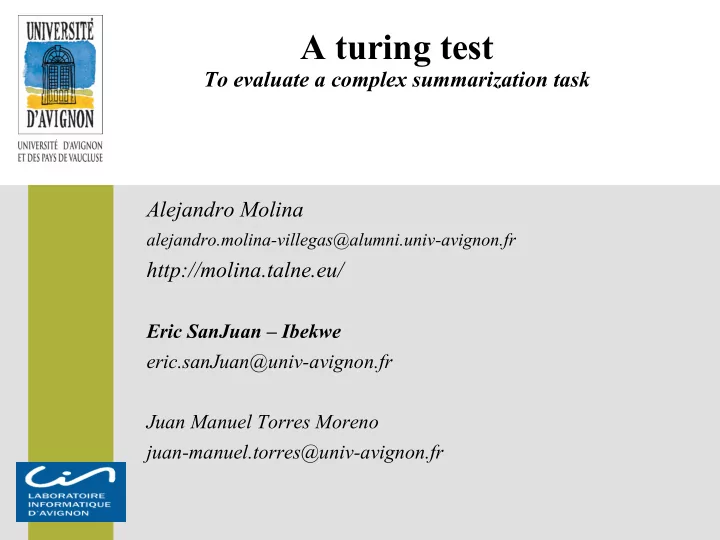

A turing test To evaluate a complex summarization task Alejandro Molina alejandro.molina-villegas@alumni.univ-avignon.fr http://molina.talne.eu/ Eric SanJuan – Ibekwe eric.sanJuan@univ-avignon.fr Juan Manuel Torres Moreno juan-manuel.torres@univ-avignon.fr
A turing test To evaluate a complex summarization task Summary 1) Automatic Summarization by Compression Task 2) Discourse segmentors Turing tests Methodology 3) Imitation Game 4) Data crowd sourcing to simulate Results a simulation game 5) Analysis
A Turing test To evaluate a complex summarization task 1) Automatic Summarization by Compression (ASC) • Automatic Summarization – by sentence extraction and scoring is easy unless breaking anaphora. – much more complex if computers are asked to cut and compress sentences like humans do. • There are usually several correct ways to compress a sentence and human experts often disagree on which is the best one. Automatic Summarization by Compression (ASC) requires to handle a high level of incertitude in the decision process since there is not a best way to compress a sentence, only observations that sometimes humans prefer one way rather than another one
A Turing test To evaluate a complex summarization task 2) Discourse segmentors • Discourse structure among other implicit semantic relations play a key role in ASC – humans tend to remove complete discourse units from sentences when they try to compress them: Molina, A., Torres-Moreno, J.M., SanJuan, E., da Cunha, I., Martinez, G.E.S. Discursive sentence compression (CICLing 2013) • We propose ASC systems based on a regression analysis of the way that assessors agree or not to remove a discourse unit. – Each discourse segmentor induces a different system. – How to compare them ?
A Turing test To evaluate a complex summarization task 3) Imitation game • two Discourse segmentors DiSeg and CoSeg used to generate compressed sentences. – Available questionnaire data for regression analysis. • 12 texts selected from the RST Spanish Tree Bank at random. – Summaries of these texts have been written down by post graduate students in linguistics from the UNAM. – Three summaries of different length (short, medium and long) were generated using DiSeg, and three other ones also of different length were generated using CoSeg. • Assessors to guess if the system is human were 54 other post graduate students.
A Turing test To evaluate a complex summarization task 4) Data (http://molina.talne.eu/)
A Turing test To evaluate a complex summarization task 4) Analysis Median number of times that an assessor thought it was a summary. Shows that CoSeg based summaries outperform DiSeg ones (p-value < 0.05)
A Turing test To evaluate a complex summarization task Conclusions & perspectives • Back to Turing’s idea of simulation game,we used crowd sourcing to simulate a simulation game to evaluate two state of the art automatic summarizers. – Usual evaluation protocols failed to differentiate between quality levels among the two system outputs. – The experiment set up here with 60 human players gives statistical evidence that one outperforms the other. • Human ability to differentiate between a summary automatically generated and summary written by an author is less than expected on such complex task. – needs to be checked out by setting up a larger crowd sourcing task. • Mixing human and machine outputs in the evaluation process seems to be a promising way to improve discriminative power of evaluation protocols.
Recommend
More recommend